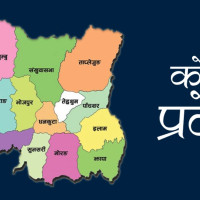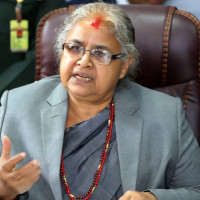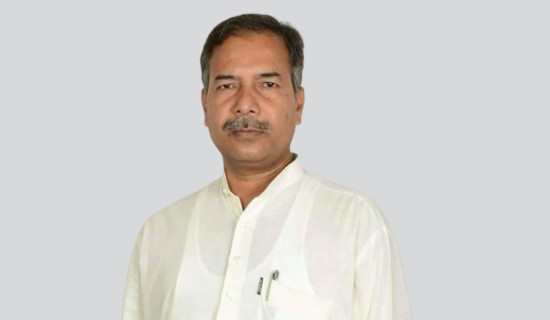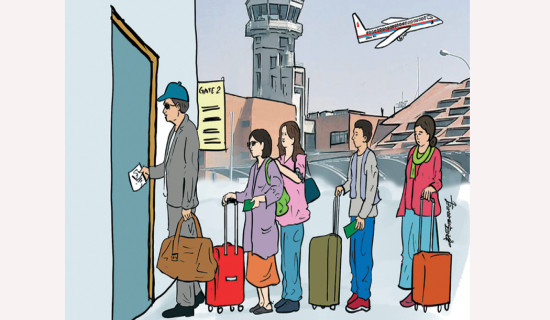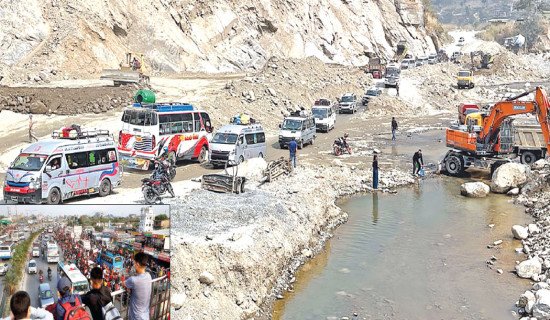- Thursday, 25 December 2025
Public's reluctance challenging national ID distribution drive
Kathmandu, May 4: Despite progressive enforcement of the National Identity Card as a mandatory government document -- eventually to replace the citizenship certificate for a range of public services -- citizens have demonstrated a notable insouciance in securing the card.
While submitting an application is obligatory for card issuance, a considerable number of applicants are reluctant to complete the process due to the requirement of physical presence to verify their biometric data.
Consequently, a significant portion of the populace has shown little interest in visiting designated centres or offices to authenticate their identity and collect it.
Meanshile, some citizens have not been able to receive their national identity cards even after visiting the municipality because some of the details they filled out during the campaigns conducted by the Department of National ID and Civil Registration (DoNIDCR) contain errors.
According to data up to mid-April 2025, the department has printed a total of 6,235,599 (6.23 million) national identity cards out of total 1,72,13,550 (17.21 million) enrollment details of general citizens’ personal and biometric details. Out of the total registration entry, only 2,312,484 (2.31 million) cards have so far been received by the respective applicants.
As per the department, of the total printed national identity cards, 6,204,448 have already been dispatched to the concerned districts.
“That means, still 65.66 per cent of the citizens haven’t shown any interest to collect their cards being physically present at the concerned places,” said Tulasi Prasad Dahal, director and chief of the National ID Management Section under the department.
According to the department, by launching a nationwide door-to-door campaign at local levels, the department managed to distribute only 1,518,027 cards.
Dahal said, "We have collected details by going from-ward-to-ward in 73 districts. Even though the ID cards are being printed, people have not come to collect them, which is why there has been a delay in distribution."
He further mentioned that this year, a campaign to distribute ID cards through local wards has been launched in 10 districts, including Kathmandu, Jhapa, Kanchanpur, and Chitwan.
In Dolpa, Mugu and Humla district, the campaign has just begun for taking their details for the enrollment. In Mustang, one permanent station office has been doing its daily work of registering and issuance of cards from there, told Dahal.
The government had officially commenced the distribution of national identity cards for the first time on November 19, 2018 from Phidim Municipality-4, Panchthar district.
"In the year 2024, following the government's decision to enforce this identification card as a compulsory requirement across various public services, a writ petition was filed in the Supreme Court on August 23, 2024. However, on January 19, 2025, the Court dismissed the petition and issued a directive order, unequivocally endorsing its mandatory implementation."
Since then, the government has gradually been making the use of National ID and at least its number compulsory from opening a bank account to issuance of SIM cards, company registration and land registration purpose.
After the government tried to make the use of cards mandatory to end the issue of double benefits in social security allowances, there was widespread criticism last year, leading to the writ petition. However, considering the country's geographical remoteness, the use of the card has not been made mandatory for people with disabilities and elderly people above the age of 90 in order to receive social security allowances.
Some citizens return empty handed
In the meantime, details submitted by hundreds of thousands during the door-to-door campaign at ward levels and through the temporary stations in various places and districts, had to return empty handed when their cards were not issued.
This has mainly happened due to errors made by the applicants themselves while submitting their details online and there are multiple other reasons which caused hindrances to issuance of the national ID cards.
Director General Yubaraj Katel said that some citizens might not have received their cards although they filled up their details during the campaigns at their doorsteps when our own technical staff filled the application remaining offline, which instead of doing it online. Submitting details of citizens on and offline can be done according to our system and when done offline, many enrollments can be done at a time and during that time, all the submitted details may not have been entered properly which led to problem in issuing the card at the delivery time to citizens, explained DG Katel.
When this scribe visited a local ward office of Nagarjun Municipality-1 in Kathmandu this week, a technical team of just two persons deputed from the department were distributing the national IDs to citizens at the ward office.
Shiva Bahadur Chhetri, 68, who was found at the ward to receive his national ID said that he could not get his card even after more than two-and-half-years of enrollment in August 2022.
“When I first reached the ward office carrying my previously filled form to receive the card, and when they checked my card details, they told me that my card was not issued yet, and I was suggested to visit the old Department of Passport located inside Narayanhiti Palace Museum to fill and provide some additional details to get the card from there,” said Chhetri.
“For what reason and why my card has not been issued by the department, even if I got notification and message of my personal national ID number on my mobile phone,” said Chhetri. The technical team arrived at the ward office said no other reason but to visit Narayanhiti Palace Museum-based National ID office to get my card, he told.
Unlike Chhetri’s situation, other citizens’ especially senior citizens have mainly faced such difficulties of non-issuance of cards.
According to the ward chairperson Rameshwar Lama of Nagarjun-1, out of over 1,700 national ID that had arrived at the ward level after nearly three years, over 35 cards could not be delivered to respective owners even though they visited the office to get their cards. Still over 550 cards are at the ward office yet to be received by the applicants, he said.
After not receiving their cards, some service recipients are now complaining that they have to go to the Narayanhiti Palace Museum and pay a certain fee (a minimum of Rs. 200) to collect their cards.
The government has made it mandatory to include the National Identity Card number in passports. Therefore, the government assumes that the number of people coming to collect their identity cards has decreased because many citizens have gone abroad after submitting their identity card details.
Additionally, due to delays in printing and its issuance, those who wish to collect their identity cards may not receive them on time, said ward chair Lama.
"Another surprising thing is that out of 14,000 citizens who applied for their cards in Ward No. 21 of Kathmandu Metropolitan City, only four citizens received their cards. Director Dahal of the department said, 'Our team is currently there to facilitate the work.'"
Such technical issues arise when some citizens build pressure to fill up their online forms during registration process although they don’t have their right and complete documents like citizenship cards and names of their three generations (grandfather, father and son/daughter).
DG Katel said that the card sometimes could not come in their name or possession as they didn’t have clear name, place, date of birth, and father’s and grandfather’s names. Some of the citizens could not get their card when a signature of the then CDO signed on the citizenship certificate was not clear.
Limited utility of card raises concerns
Despite the government’s push to make the national identity card mandatory, its intended utility has yet to be realised due to the lack of integration with essential public services. Although authorities initially claimed that a unified system would allow citizens to access various services through a single ID, that vision remains largely unfulfilled so far.
The National Identity Card was expected to be linked with critical public service sectors including the Department of Passports, Land Revenue Office, Transport Management Department, Civil Registration Office, local governments, banks, telecommunications providers, driving license authorities, Public Service Commission, and the PAN.
However, the government has not actively pursued integration with these services, rendering the card practically ineffective so far.
In response, the government has initiated efforts to enhance the card’s utility across multiple sectors.
DG Katel confirmed that preparations are underway to publish a notice in the Nepal Gazette allowing the national identity card to serve as a substitute for the citizenship certificate. Officials believe that once this provision is activated, both the distribution and use of the identity cards will increase significantly.
The government is also working on a policy to formally recognize the national ID for services that currently require a citizenship certificate, including social security benefits, tax administration, and health insurance. This move is expected to significantly elevate the relevance and adoption of the national identity card among the public.




